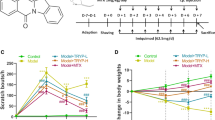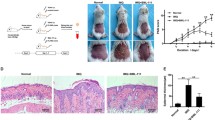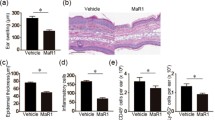Abstract
Psoriasis is a chronic inflammatory skin disease. Inflammation and oxidative stress play crucial roles in the pathogenesis of psoriasis. Cannabinoid receptor type 2 (CB2R) is an attractive target for treating various inflammatory disorders. However, the precise role and mechanism of CB2R activation in psoriasis remain to be further elucidated. In this study, imiquimod (IMQ)-induced experimental psoriasis mice and tumor necrosis factor-α (TNF-α)-activated keratinocytes (HaCaT) were used to examine the effect of CB2R activation on psoriasis-like lesions and the mechanism in vivo and in vitro. Our results demonstrated that activation of CB2R by the specific agonist GW842166X (GW) significantly ameliorated IMQ-induced psoriasiform skin lesions in mice by reducing epidermal thickness and decreasing plaque thickness. On the one hand, GW alleviated inflammation by decreasing inflammatory cytokines and abating inflammatory cell infiltration. On the other hand, this treatment reduced the level of iNOS and downregulated the expression of CB2R in psoriatic skin tissue. Further studies suggested that the Kelch-like ECH-associated protein 1/nuclear factor erythroid-2-related factor (Keap1/Nrf2) signaling pathway might be involved. Our findings reveal that selective activation of CB2R may serve as a new strategy for the treatment of psoriasis.








Similar content being viewed by others
Availability of Data and Materials
All data generated or analyzed during this study are included in this published article and its supplementary information files.
References
Dobrică, E.C., M.A. Cozma, M.A. Găman, et al. 2022. The Involvement of Oxidative Stress in Psoriasis: A Systematic Review. Antioxidants 11 (2): 282. https://doi.org/10.3390/antiox11020282.
Boehncke, W.-H., and M.P. Schön. 2015. Psoriasis. The Lancet 386 (9997): 983–994. https://doi.org/10.1016/s0140-6736(14)61909-7.
Armstrong, A.W., and C. Read. 2020. Pathophysiology, Clinical Presentation, and Treatment of Psoriasis: A Review. Journal of American Medical Association 323 (19): 1945–1960. https://doi.org/10.1001/jama.2020.4006.
Rendon, A., and K. Schakel. 2019. Psoriasis Pathogenesis and Treatment. International Journal of Molecular Sciences 20 (6): 1475. https://doi.org/10.3390/ijms20061475.
Rio, C.D., E. Millan, V. Garcia, et al. 2018. The endocannabinoid system of the skin. A potential approach for the treatment of skin disorders. Biochemical Pharmacology 157: 122–133. https://doi.org/10.1016/j.bcp.2018.08.022.
Gęgotek, A., M. Biernacki, E. Ambrożewicz, et al. 2016. The cross-talk between electrophiles, antioxidant defence and the endocannabinoid system in fibroblasts and keratinocytes after UVA and UVB irradiation. Journal of Dermatological Science 81 (2): 107–117. https://doi.org/10.1016/j.jdermsci.2015.11.005.
Lu, H.C., and K. Mackie. 2021. Review of the Endocannabinoid System. Biological Psychiatry: Cognitive Neuroscience and Neuroimaging 6 (6): 607–615. https://doi.org/10.1016/j.bpsc.2020.07.016.
Aso, E., and I. Ferrer. 2016. CB2 Cannabinoid Receptor As Potential Target against Alzheimer’s Disease. Frontiers in Neuroscience 10: 243. https://doi.org/10.3389/fnins.2016.00243.
Martins, A.M., A.L. Gomes, I. Vilas Boas, et al. 2022. Cannabis-Based Products for the Treatment of Skin Inflammatory Diseases: A Timely Review. Pharmaceuticals 15 (2): 210. https://doi.org/10.3390/ph15020210.
Cheng, X., J. Lin, Z. Chen, et al. 2021. CB2-mediated attenuation of nucleus pulposus degeneration via the amelioration of inflammation and oxidative stress in vivo and in vitro. Molecular Medicine 27 (1): 92. https://doi.org/10.1186/s10020-021-00351-x.
Rajesh, M., P. Mukhopadhyay, S. Bátkai, et al. 2022. Cannabinoid receptor 2 activation alleviates diabetes-induced cardiac dysfunction, inflammation, oxidative stress, and fibrosis. Geroscience 44 (3): 1727–1741. https://doi.org/10.1007/s11357-022-00565-9.
Zhao, Z., J. Yang, H. Zhao, et al. 2012. Cannabinoid receptor 2 is upregulated in melanoma. Journal of Cancer Research and Therapeutics 8 (4): 549–554. https://doi.org/10.4103/0973-1482.106534.
Ramot, Y., K. Sugawara, N. Zákány, et al. 2013. A novel control of human keratin expression: cannabinoid receptor 1-mediated signaling down-regulates the expression of keratins K6 and K16 in human keratinocytes in vitro and in situ. PeerJ 1: e40. https://doi.org/10.7717/peerj.40.
Toth, K.F., D. Adam, T. Biro, et al. 2019. Cannabinoid Signaling in the Skin: Therapeutic Potential of the “C(ut)annabinoid” System. Molecules 24 (5): 918. https://doi.org/10.3390/molecules24050918.
Du, Y., P. Ren, Q. Wang, et al. 2018. Cannabinoid 2 receptor attenuates inflammation during skin wound healing by inhibiting M1 macrophages rather than activating M2 macrophages. Journal of Inflammation 15: 25. https://doi.org/10.1186/s12950-018-0201-z.
Maddukuri, S., J. Patel, D.A. Diaz, et al. 2022. Cannabinoid type 2 receptor (CB2R) distribution in dermatomyositis skin and peripheral blood mononuclear cells (PBMCs) and in vivo effects of LenabasumTM. Arthritis Research & Therapy 24 (1): 12. https://doi.org/10.1186/s13075-021-02665-x.
Norooznezhad, A.H., and F. Norooznezhad. 2017. Cannabinoids: Possible agents for treatment of psoriasis via suppression of angiogenesis and inflammation. Medical Hypotheses 99: 15–18. https://doi.org/10.1016/j.mehy.2016.12.003.
Li, L., X. Liu, W. Ge, et al. 2022. CB2R Deficiency Exacerbates Imiquimod-Induced Psoriasiform Dermatitis and Itch Through the Neuro-Immune Pathway. Frontiers in Pharmacology 13: 790712. https://doi.org/10.3389/fphar.2022.790712.
Lin, X., and T. Huang. 2016. Oxidative stress in psoriasis and potential therapeutic use of antioxidants. Free Radical Research 50 (6): 585–595. https://doi.org/10.3109/10715762.2016.1162301.
Xue, Q., Y. Yan, R. Zhang, et al. 2018. Regulation of iNOS on Immune Cells and Its Role in Diseases. International Journal of Molecular Sciences 19 (12): 3805. https://doi.org/10.3390/ijms19123805.
Ormerod, A.D., R. Weller, P. Copeland, et al. 1998. Detection of nitric oxide and nitric oxide synthases in psoriasis. Archives Of Dermatological Research 290 (1–2): 3–8. https://doi.org/10.1007/s004030050268.
Simonetti, O., G. Lucarini, A. Campanati, et al. 2009. VEGF, survivin and NOS overexpression in psoriatic skin: critical role of nitric oxide synthases. Journal of Dermatological Sience 54 (3): 205–208. https://doi.org/10.1016/j.jdermsci.2008.12.012.
Li, X., D. Han, Z. Tian, et al. 2016. Activation of Cannabinoid Receptor Type II by AM1241 Ameliorates Myocardial Fibrosis via Nrf2-Mediated Inhibition of TGF-β1/Smad3 Pathway in Myocardial Infarction Mice. Cellular Physiology and Biochemistry 39 (4): 1521–1536. https://doi.org/10.1159/000447855.
Zoppi, S., J.L. Madrigal, J.R. Caso, et al. 2014. Regulatory role of the cannabinoid CB2 receptor in stress-induced neuroinflammation in mice. British Journal of Pharmacology 171 (11): 2814–2826. https://doi.org/10.1111/bph.12607.
Zhang, M., M. Zhang, L. Wang, et al. 2019. Activation of cannabinoid type 2 receptor protects skeletal muscle from ischemia-reperfusion injury partly via Nrf2 signaling. Life Sciences 230: 55–67. https://doi.org/10.1016/j.lfs.2019.05.056.
Yue, L., W. Ailin, Z. Jinwei, et al. 2019. PSORI-CM02 ameliorates psoriasis in vivo and in vitro by inducing autophagy via inhibition of the PI3K/Akt/mTOR pathway. Phytomedicine 64: 153054. https://doi.org/10.1016/j.phymed.2019.153054.
Baker, B.S., L. Brent, H. Valdimarsson, et al. 1992. Is epidermal cell proliferation in psoriatic skin grafts on nude mice driven by T-cell derived cytokines? British Journal of Dermatology 126 (2): 105–110. https://doi.org/10.1111/j.1365-2133.1992.tb07805.x.
Schindelin, J., I. Arganda-Carreras, E. Frise, et al. 2012. Fiji: an open-source platform for biological-image analysis. Nature Methods 9 (7): 676–682. https://doi.org/10.1038/nmeth.2019.
Mercurio, L., M. Morelli, C. Scarponi, et al. 2018. IL-38 has an anti-inflammatory action in psoriasis and its expression correlates with disease severity and therapeutic response to anti-IL-17A treatment. Cell Death & Disease 9 (11): 1104. https://doi.org/10.1038/s41419-018-1143-3.
Shi, H.J., H. Zhou, A.L. Ma, et al. 2019. Oxymatrine therapy inhibited epidermal cell proliferation and apoptosis in severe plaque psoriasis. British Journal of Dermatology 181 (5): 1028–1037. https://doi.org/10.1111/bjd.17852.
Thatikonda, S., V. Pooladanda, D.K. Sigalapalli, et al. 2020. Piperlongumine regulates epigenetic modulation and alleviates psoriasis-like skin inflammation via inhibition of hyperproliferation and inflammation. Cell Death & Disease 11 (1): 21. https://doi.org/10.1038/s41419-019-2212-y.
Wu, S., M. Zhao, Y. Sun, et al. 2020. The potential of Diosgenin in treating psoriasis: Studies from HaCaT keratinocytes and imiquimod-induced murine model. Life Sciences 241: 117115. https://doi.org/10.1016/j.lfs.2019.117115.
Giblin, G.M., C.T. O’Shaughnessy, A. Naylor, et al. 2007. Discovery of 2-[(2,4-dichlorophenyl)amino]-N-[(tetrahydro- 2H-pyran-4-yl)methyl]-4-(trifluoromethyl)- 5-pyrimidinecarboxamide, a selective CB2 receptor agonist for the treatment of inflammatory pain. Journal Of Medicinal Chemistry 50 (11): 2597–2600. https://doi.org/10.1021/jm061195+.
Ostenfeld, T., J. Price, M. Albanese, et al. 2011. A randomized, controlled study to investigate the analgesic efficacy of single doses of the cannabinoid receptor-2 agonist GW842166, ibuprofen or placebo in patients with acute pain following third molar tooth extraction. The Clinical Journal of Pain 27 (8): 668–676. https://doi.org/10.1097/AJP.0b013e318219799a.
Yu, H., X. Liu, B. Chen, et al. 2021. The Neuroprotective Effects of the CB2 Agonist GW842166x in the 6-OHDA Mouse Model of Parkinson’s Disease. Cells 10 (12): 3548. https://doi.org/10.3390/cells10123548.
Liu, X., H. Yu, B. Chen, et al. 2022. CB2 Agonist GW842166x Protected against 6-OHDA-Induced Anxiogenic- and Depressive-Related Behaviors in Mice. Biomedicines 10 (8): 1776. https://doi.org/10.3390/biomedicines10081776.
Gao, J., F. Chen, H. Fang, et al. 2020. Daphnetin inhibits proliferation and inflammatory response in human HaCaT keratinocytes and ameliorates imiquimod-induced psoriasis-like skin lesion in mice. Biological Research 53 (1): 48. https://doi.org/10.1186/s40659-020-00316-0.
Zhou, X., Y. Chen, L. Cui, et al. 2022. Advances in the pathogenesis of psoriasis: from keratinocyte perspective. Cell Death & Disease 13 (1): 81. https://doi.org/10.1038/s41419-022-04523-3.
Ogawa, E., Y. Sato, A. Minagawa, et al. 2018. Pathogenesis of psoriasis and development of treatment. The Journal of Dermatology 45 (3): 264–272. https://doi.org/10.1111/1346-8138.14139.
Singh, R., S. Koppu, P.O. Perche, et al. 2021. The Cytokine Mediated Molecular Pathophysiology of Psoriasis and Its Clinical Implications. International Journal of Molecular Sciences 22 (23): 12793. https://doi.org/10.3390/ijms222312793.
Gangwar, R.S., J.E. Gudjonsson, and N.L. Ward. 2022. Mouse Models of Psoriasis: A Comprehensive Review. Journal of Investigative Dermatology 142 (3): 884–897. https://doi.org/10.1016/j.jid.2021.06.019.
Hawkes, J.E., J.E. Gudjonsson, and N.L. Ward. 2017. The Snowballing Literature on Imiquimod-Induced Skin Inflammation in Mice: A Critical Appraisal. Journal of Investigative Dermatology 137 (3): 546–549. https://doi.org/10.1016/j.jid.2016.10.024.
Zhang, S., J. Zhang, J. Yu, et al. 2021. Hyperforin ameliorates imiquimod-induced psoriasis-like murine skin inflammation by modulating IL-17A-producing γδ T Cells. Frontiers in Immunology 12: 635076. https://doi.org/10.3389/fimmu.2021.635076.
van der Fits, L., S. Mourits, J.S. Voerman, et al. 2009. Imiquimod-induced psoriasis-like skin inflammation in mice is mediated via the IL-23/IL-17 axis. Journal of Immunology 182 (9): 5836–5845. https://doi.org/10.4049/jimmunol.0802999.
Frenzel, D.F., L. Borkner, J. Scheurmann, et al. 2015. Osteopontin deficiency affects imiquimod-induced psoriasis-like murine skin inflammation and lymphocyte distribution in skin, draining lymph nodes and spleen. Experimental Dermatology 24 (4): 305–307. https://doi.org/10.1111/exd.12649.
Chen, H., H. Liu, C. Lu, et al. 2017. PSORI-CM02 Formula Increases CD4+ Foxp3+ Regulatory T Cell Frequency and Ameliorates Imiquimod-Induced Psoriasis in Mice. Frontiers in Immunology 8: 1767. https://doi.org/10.3389/fimmu.2017.01767.
Yan, K., W. Xu, Y. Huang, et al. 2018. Methotrexate restores the function of peripheral blood regulatory T cells in psoriasis vulgaris via the CD73/AMPK/mTOR pathway. British Journal of Pharmacology 179 (4): 896–905. https://doi.org/10.1111/bjd.16560.
Li, L., H.Y. Zhang, X.Q. Zhong, et al. 2020. PSORI-CM02 formula alleviates imiquimod-induced psoriasis via affecting macrophage infiltration and polarization. Life Sciences 243: 117231. https://doi.org/10.1016/j.lfs.2019.117231.
Jiang, P., L. Wang, M. Zhang, et al. 2020. Cannabinoid type 2 receptor manipulates skeletal muscle regeneration partly by regulating macrophage M1/M2 polarization in IR injury in mice. Life Sciences 256: 117989. https://doi.org/10.1016/j.lfs.2020.117989.
Tortora, C., A. Di Paola, M. Argenziano, et al. 2022. Effects of CB2 Receptor Modulation on Macrophage Polarization in Pediatric Celiac Disease. Biomedicines 10 (4): 874. https://doi.org/10.3390/biomedicines10040874.
Charachit, N., A. Sukhamwang, P. Dejkriengkraikul, et al. 2022. Hyperoside and Quercitrin in Houttuynia cordata Extract Attenuate UVB-Induced Human Keratinocyte Cell Damage and Oxidative Stress via Modulation of MAPKs and Akt Signaling Pathway. Antioxidants 11 (2): 221. https://doi.org/10.3390/antiox11020221.
Kim, S.Y., S.D. Han, M. Kim, et al. 2021. Mentha arvensis Essential Oil Exerts Anti-Inflammatory in LPS-Stimulated Inflammatory Responses via Inhibition of ERK/NF-κB Signaling Pathway and Anti-Atopic Dermatitis-like Effects in 2,4-Dinitrochlorobezene-Induced BALB/c Mice. Antioxidants 10 (12): 1941. https://doi.org/10.3390/antiox10121941.
Niedbala, W., B. Cai, and F.Y. Liew. 2006. Role of nitric oxide in the regulation of T cell functions. Annals of the Rheumatic Diseases 65 (Suppl 3): iii37–iii40. https://doi.org/10.1136/ard.2006.058446.
Jianjun, Y., R. Zhang, G. Lu, et al. 2013. T cell–derived inducible nitric oxide synthase switches off Th17 cell differentiation. Journal of Experimental Medicine 210 (7): 1447–1462. https://doi.org/10.1084/jem.20122494.
Bogdan, C., M. Röllinghoff, and A. Diefenbach. 2000. The role of nitric oxide in innate immunity. Immunological Reviews 173 (1): 17–26. https://doi.org/10.1034/j.1600-065x.2000.917307.x.
Xiong, H., C. Zhu, F. Li, et al. 2004. Inhibition of interleukin-12 p40 transcription and NF-kappaB activation by nitric oxide in murine macrophages and dendritic cells. Journal of Biological Chemistry 279 (11): 10776–10783. https://doi.org/10.1074/jbc.M313416200.
Gómez-Gálvez, Y., C. Palomo-Garo, J. Fernández-Ruiz, et al. 2016. Potential of the cannabinoid CB(2) receptor as a pharmacological target against inflammation in Parkinson’s disease. Progress in Neuro-Psychopharmacology and Biological Psychiatry 64: 200–208. https://doi.org/10.1016/j.pnpbp.2015.03.017.
Morris, G., K. Walder, M. Berk, et al. 2022. Intertwined associations between oxidative and nitrosative stress and endocannabinoid system pathways: Relevance for neuropsychiatric disorders. Progress in Neuro-Psychopharmacology and Biological Psychiatry 114: 110481. https://doi.org/10.1016/j.pnpbp.2021.110481.
Singh, S., D.K. Singh, A. Meena, et al. 2019. Rutin protects t-butyl hydroperoxide-induced oxidative impairment via modulating the Nrf2 and iNOS activity. Phytomedicine 55: 92–104. https://doi.org/10.1016/j.phymed.2018.07.009.
Ogawa, T., and Y. Ishitsuka. 2022. The Role of KEAP1-NRF2 System in Atopic Dermatitis and Psoriasis. Antioxidants 11 (7): 1397. https://doi.org/10.3390/antiox11071397.
Panieri, E., P. Telkoparan-Akillilar, and L. Saso. 2022. NRF2, a crucial modulator of skin cells protection against vitiligo, psoriasis, and cancer. Biofactors 1912. https://doi.org/10.1002/biof.1912.
Ogawa, T., Y. Ishitsuka, S. Inoue, et al. 2020. Nuclear Factor Erythroid 2-Related Factor 2 (Nrf2) Regulates Epidermal Keratinization under Psoriatic Skin Inflammation. American Journal of Pathology 190 (3): 577–585. https://doi.org/10.1016/j.ajpath.2019.10.022.
Yang, L., X. Fan, T. Cui, et al. 2017. Nrf2 Promotes Keratinocyte Proliferation in Psoriasis through Up-Regulation of Keratin 6, Keratin 16, and Keratin 17. Journal of Investigative Dermatology 137 (10): 2168–2176. https://doi.org/10.1016/j.jid.2017.05.015.
Phan, N.Q., D. Siepmann, I. Gralow, et al. 2010. Adjuvant topical therapy with a cannabinoid receptor agonist in facial postherpetic neuralgia. Journal of the German Society of Dermatology 8 (2): 88–91. https://doi.org/10.1111/j.1610-0387.2009.07213.x.
Przybycień, P., D. Gąsior-Perczak, and W. Placha. 2022. Cannabinoids and PPAR Ligands: The Future in Treatment of Polycystic Ovary Syndrome Women with Obesity and Reduced Fertility. Cells 11 (16): 2569. https://doi.org/10.3390/cells11162569.
Acknowledgements
The authors acknowledge Xia Lei, director of the Department of Dermatovenerology of Daping Hospital, for her warm help to our work. The authors also acknowledge Haigang Zhang, director of the Department of Pharmacology of Army Medical University, for supporting this study.
Funding
This work was supported by the National Natural Science Foundation of China (Grant number: 82174061).
Author information
Authors and Affiliations
Contributions
Tao Liu and Renshan Sun designed the experiments. Yufeng He and Honglin Jia performed experiments. Xiaohong Chen and Wenjun Shan contributed to preparing reagents, materials, and experimental equipment. Tao Liu, Yufeng He, Qunfang Yang and Xianqiong Huang analyzed the data. Yufeng He and Tao Liu wrote the article. Tao Liu and Renshan Sun revised the article. All authors read and approved the final article.
Corresponding authors
Ethics declarations
Ethics Approval and Consent to Participate
The protocol of animal study was reviewed and approved by Laboratory Animal Welfare and Ethics Committee of Army Medical University.
Consent for Publication
The consent of all coauthors was collected before submission.
Competing Interests
The authors declare that they have no competing interests.
Additional information
Publisher's Note
Springer Nature remains neutral with regard to jurisdictional claims in published maps and institutional affiliations.
Supplementary Information
Below is the link to the electronic supplementary material.
Rights and permissions
Springer Nature or its licensor (e.g. a society or other partner) holds exclusive rights to this article under a publishing agreement with the author(s) or other rightsholder(s); author self-archiving of the accepted manuscript version of this article is solely governed by the terms of such publishing agreement and applicable law.
About this article
Cite this article
He, Y., Jia, H., Yang, Q. et al. Specific Activation of CB2R Ameliorates Psoriasis-Like Skin Lesions by Inhibiting Inflammation and Oxidative Stress. Inflammation 46, 1255–1271 (2023). https://doi.org/10.1007/s10753-023-01805-6
Received:
Revised:
Accepted:
Published:
Issue Date:
DOI: https://doi.org/10.1007/s10753-023-01805-6




